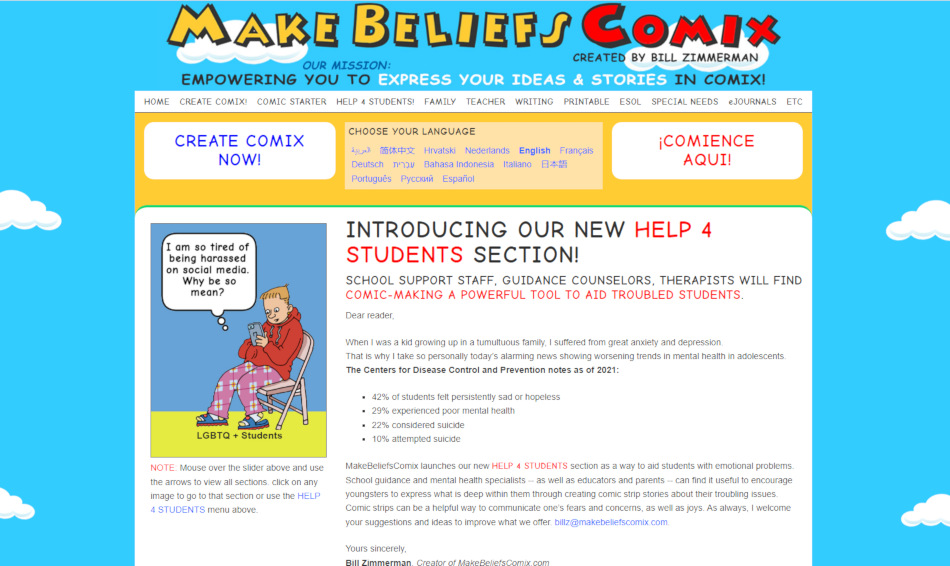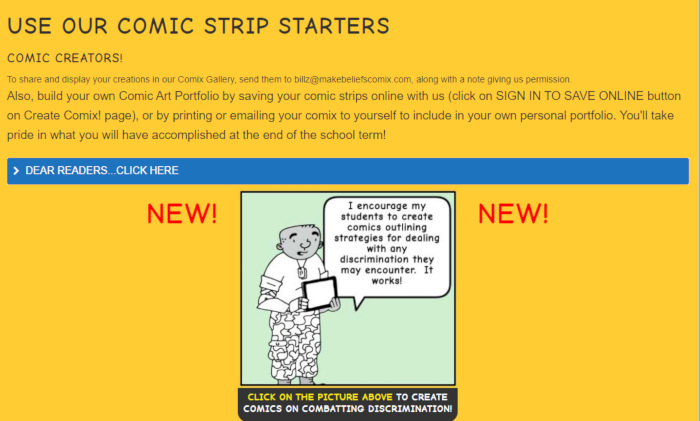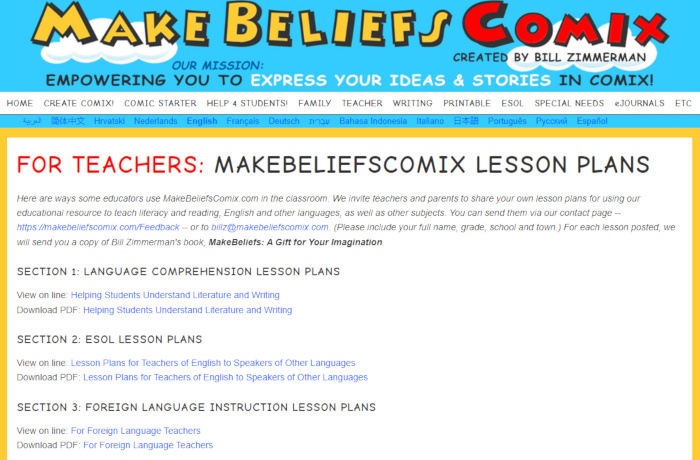How to Use Comics in Your Classroom, With MakeBeliefsComix Founder Bill Zimmerman
Advice and best practices for using comics and MakeBeliefsComix to teach

In my work writing about the most useful free and low-cost tech tools for teachers, I’m always on the lookout for a resource whose authenticity and inventiveness shine forth like a lodestar. MakeBeliefsComix is one such site. That’s why when creator Bill Zimmerman reached out to tell me about a new section on the site, I jumped at the chance to learn more about it and how to best use comics with students.
A multiple-award winning resource, MakeBeliefsComix provides an abundance of ideas and tools so that kids can express their creativity, feelings, and thoughts through comics. No artistic talent is required, as an extensive collection of cleverly drawn cartoon images—characters, backgrounds, speech and thought balloons, monsters, animals, and more—provide the graphic foundation for any comic. This remarkable comic-creation site is also free to use for all.
T&L: How can teachers and therapists use comics and resources such as MakeBeliefsComix to help troubled students?
Zimmerman: Over the years many educational therapists have used MakeBeliefsComix with students with special needs, such as autism and behavioral problems (see our Case Studies section). As kids’ anxiety and depression rose from the effects of the COVID19 pandemic and other problems, we began a series of weekly interactive MakeBeliefs titled ‘’MakeBeliefs to Help U Smile & Find Joy.’’ Here youngsters are prompted to find something positive to say about their lives or express their hopes. We just launched a HELP 4 STUDENTS section to broaden the communication options for school support staff, educators, parents and youngsters. The section includes help for mentally disturbed youngsters, LBGTQ+ students and those suffering distress due to racial or gender discrimination.
A support person can work one-on-one with a student in using the comic prompts to build the student’s stories and use them as a jumping-off board for deeper discussion. A student may want to use the material strictly on their own to explore their personal issues and build up a personal portfolio of their journey in school and life. The key is to get the student expressing what is on their mind.
How can a teacher best use comics and MakeBeliefsComix to teach?
Our mission with the site is to get kids to use their imaginations, to read, write and communicate their thoughts through comics.
Tools and ideas to transform education. Sign up below.
I would encourage a teacher to look with students on the homepage to get a sense of what the MakeBeliefsComix site is about. Then click to the most important page on the site – Create Comix! Students can explore the tools, characters, speech balloons, backgrounds, and other features available to create their comics.
When I’ve worked with schools, for the first comic, the students and I would create a three or four-panel story together. I might click on the characters and ask which one or two they’d like to choose. Then I’d then pull up two thought or talk balloons for which the kids would supply words. Sowly, but surely, we would build a story together. The class can also choose a theme for the story or use the comic strip to review material they had learned in class that day, or to summarize or storyboard a book they have been reading together. There’s a helpful video demo here.

We also feature a special Comic Starters section in which we offer writing prompt panels to begin their comic. Kids can add blank panels to write their responses with their own choice of characters.
Sometimes it’s useful to break the class into small teams to work on a comic strip together. That allows them to gain confidence in creating stories while helping one another. Another idea is for the teacher to assign a book they all know and ask the class to extend the story after it ends. Having students work with each other on making comics is particularly effective in English Language Learning classes, where students are experimenting with a new language. And the task of filling in talk balloons in small chunks is not threatening.
The Printables section on the site offers hundreds of printables on which kids can draw or write their thoughts and expressions. There is even an Interactive PdF printables category which enables students to write directly on the screen from their digital device. The printables can be a good warmup to creating a comic strip story.
I would also recommend the eJournals section, which is made up of free downloadable interactive ebooks in which students can write their thoughts and feelings. The books, with their question/writing prompts, provide good structure for students.
Can kids who aren't fluent in drawing use the site?
The site is very empowering for kids who aren’t great at drawing their own comics. It gives them the ability to create stories by supplying them with more than 100 characters to choose from, with beautiful backgrounds and objects and other art resources to dress up their stories. In effect, each student using the site becomes an artist, a writer and an editor with the assistance of the prompts and tools we provide.
What do you want teachers and students to know most about the new MakeBeliefsComix resources?
All the resources on MakeBeliefsComix are directed in helping students, with the help of comics, find their voice in expressing their ideas and deepest thoughts.
I created something that I needed as a fearful young person myself who felt closed and locked in because of difficult family issues at home and didn’t have an adequate way or encouragement to express myself. I also had a terrible time learning how to read. I think young people have many things to say, some happy, some sad, which reflect their lives.
The new HELP 4 STUDENTS section is geared to help those students with emotional problems as a way to deal with their issues by creating stories about themselves. Each of us has something important to say and creating comics, using comic characters as surrogate versions of ourselves, makes telling our stories easier.
Teachers might also find our Lesson Plans Page useful as well as our Ideas Exchange page in which educators share ideas on how they use the site in the classroom. There is an SEL section as well here.

Makebeliefscomix.com is fully free for all users, but does include ads. Do you have standards for the types of advertising that you accept?
Yes, we do! We're very careful about the types of ads we allow, making every effort to ensure ads are family-friendly. We work with our ad network technology provider, Google AdSense, to exclude dangerous products or services, inappropriate/offensive content and products or services that enable dishonest behavior, among other restrictions. We also block certain sensitive ad categories, such as gambling, alcohol, and other categories we've determined might be inappropriate for classroom or family use. Occasionally, we may block specific advertisements that fall outside of a blocked sensitive category but we feel the content may offend some of our visitors.
I wish we didn’t have to have ads (we originally started in 2006 with none), but we needed additional income to keep the site going and expand its content. For example, we started with only eight comic characters when we first launched – now there’s more than 100 to choose from.
Does Makebeliefscomix.com collect information on users who create an account?
When users create comic strips for free on MakeBeliefsComix.com without creating an account or logging into the site we do not collect any user information. When a user creates an account with a combination username and password we store the information so the user can log in to save, view and edit their stored comix. The only other information we collect are the email addresses users send us to log on to the system. We do not use that information or provide or send to others. As is the case most of the time when ads are displayed on websites, an ad network (ours is Google AdSense), uses non-personally identifiable information to better understand the effectiveness of ads.
How has your background as a career journalist informed your vision of MakeBeliefsComix? Do you see an overlap between teaching and journalism?
I have always looked upon journalism as a way to educate people about the world and to help give them through my writing a voice about the important issues in their lives. For many years I was a senior editor at Newsday newspaper where I created a nationally syndicated Student Briefing Page on the News to teach them about current events and to elicit their opinions and thoughts. It was among the first newspapers in the nation to employ interactive learning techniques.
At the same I also was writing more than 30 interactive books for youngsters to help them write about what was in their hearts and imagination. As a journalist I got paid to ask questions, and as a writer of books, I continue to ask more questions to encourage creating thinking. I have spent my whole life looking for answers.
In the early days of COVID, we created a Comic Starter on COVID and printed the comics youngsters would send us in response to the questions posed about how the virus affected their lives. There is even a Journalism Comic Starter page on the site to assess student opinion about news issues.
I encourage all readers to explore and test out the many creative features that establish MakeBeliefsComix as a standout educational site. Teachers, students and parents are invited to share their feedback via the MakeBeliefsComix contact page.
To share your feedback and ideas on this article, consider joining our Tech & Learning online community here
Tech & Learning editor and contributor since 2010, Diana is dedicated to ferreting out the best free and low-cost tech tools for teachers.
